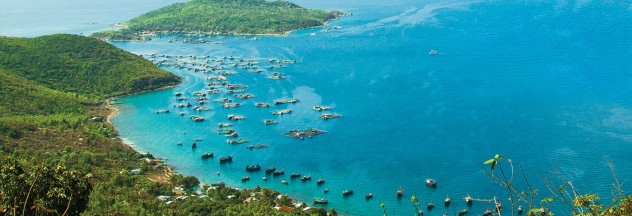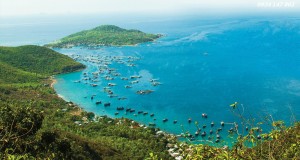For people looking for an ideal vacation spot in Vietnam or for nature lovers as a whole, Cam Ranh Bay is one place you shouldn’t miss with its myriad of breathtaking sights which makes it no wonder then why it has become a popular tourist destination through time.
Cam Ranh Bay can be reached through Nha Trang City, then take a 40-kilometer ride from the National Highway Number 1 to the South, turn East, then pass through Long Ho Bridge. It is about 100 kms. sq. in size, between five to six kilometers in width, almost 15 kilometers in length and around 15-20 meters deep. It is enclosed by mountains on three sides and the sea on the fourth, making it a naturally closed, wide and deep bay. The water is calm throughout the year making it natural to produce up to about ten thousand tons of large-tonnage ships at the port and 20 thousand tons at the bay door.
Cam Ranh Bay’s attraction to visitors from all over the world is well-justified. Its landscape is breathtaking to say the least. The coast is lined with charming residential areas while the peninsula across is a beauty of its own. Yellow apricots ceaselessly bloom the whole year. Mornings at Cam Ranh Bay can become crowded and noisy with the daily economic activities of the local residents, an exciting sight for adventure-seeking tourists. But the evenings are the exact opposite, quiet and calm as everyone rests and prepares for another day, a much-needed solitude for visitors escaping from the hustle and bustle of their city life.
Ba Ngoi, Da Bac and Bao Gieng are known as lovely residential areas in Cam Ranh while Mi Ca, Binh Ba and Vung Nom Communes beautify the peninsula. If you want eternal fresh sea breeze and stunning scenery, Binh Ba Commune offers such natural luxury with just a 40-minute boat ride from Da Bac (Ba Ngoi) port. Vung Nom Commune is a bustling fishing village situated at a quiet riverbank surrounded by huge gardens, coconut and longan trees.
Aside from its natural scenery, the culinary culture of Cam Ranh Bay is also one of its prides. It is famous for its blood cockle, a sea creature resembling the taste of the equally famed lobster of O Loan Lagoon in Phu Yen Province. It can be found in Thuy Trieu Lagoon which has a shallow water tide perfect for a blood cockle to breed. Binh Ba also boasts of its enormous lobsters which can grow between seven to eight kilos and have antennaes about one meter long. Snail, crab, seaweed, squid and fish also thrive in the area. Cam Ranh also stands out for its unique kind of mango fruit which can be found exclusively in the bay. The one-of-a-kind mango grows in the summer, is smaller than the usual size but extraordinarily sweet. All foods are cheap, making it even more appealing to anyone visiting the place.
Goods exported from the central Highlands also pass through Cam Ranh Bay. As such, the bay is also known as one of the national major gateways in exporting items like rubber, tea, tobacco, coffee, sugar, fruits and forestry products. Industries such as chemical, and glass and crystal production also stand a good chance at Cam Ranh since Ba Ngoi is rich in white sand which contains sillic, the material used for such processes. Shipping, fishing and seafood processing businesses can also serve as suppliers to hotels, restaurants and other establishments in Cam Ranh.
Cam Ranh Bay is already rich in natural resources. And yet, it even holds a promise for other sectors to develop such as tourism, industry and the economy as a whole. This is why Cam Ranh Bay continues to attract people from all over the world with its simple yet mysterious charm.

